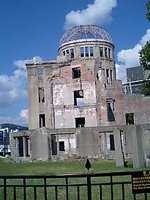
After hitting the breakfast viking - featuring both Japanese and Western-style food - we were able to purchase the one-day ferry and streetcar passport from the hotel front desk. At 840 yen, it's a good deal if you're heading out to Miyajima for the day, as was our plan. We checked out and walked the two blocks to the station, where we stashed our stuff in the station lockers before hopping on the streetcar.
After arriving at the ferry port, about an hour's journey, we tried the local okonomiyaki at the terminal and then boarded the ferry for the 10-minute ride to the island. Walking toward the beautiful floating torii that is such a famous symbol in Japan, we were accosted by some of the many wild deer that wander around the shrine's grounds and the surrounding area. Signs proclaim: "watch out for deer with horns!" but mostly they're gentle and peaceful creatures, who allow themselves to be petted and may occasionally give a passerby a nudge as a request for a snack, such as the shika-senbei that some vendors peddle at the roadside.
Itsukushima shrine sits at the edge of the water and is built on stilts and planks, so that at high tide it seems that the whole shrine, and not just the red torii, is floating. After walking around the grounds for awhile (300 yen admission), we hiked up to the ropeway station and boarded the gondola for Mt. Mizen. Changing to a funicular car halfway up, we were interrogated by an old grandpa travelling with his wife and two grandsons. "Where are you from?" he fired off. "Where do you live?" and "What do you think of this place?" His charges seemed simultaneously amused and abashed.
Unfortunately for us, the islands famed wild monkeys did not make an appearance on the mountain. When my mom and sister visited two years ago, they got to witness the spectacle of a monkey chasing a young boy down the hill, the boy clutching a knapsack filled with snacks that the monkey was intent on capturing for himself.
The view from the top of Mt. Mizen is lovely, as is the walk back down the mountain through the Momijikoen - maple leaf park. Here we were able to see koyo - the fiery changing of the leaves, most prominent on maple trees.

Back in Hiroshima, we sought a vegan macrobiotic restaurant that had been discovered online by B. Supposed to be located next to the Kannon-machi post office, we went wandering around Kannon-machi trying to find it. We asked in a big post office only a block from the borders of Kannon-town, but even when an army of clerks pored over maps trying to help us locate the spot, they had trouble finding it. Finally we discovered that it was still a ways away, and procured a crudely drawn map. We went outside and hailed a cab posthaste, and the extremely friendly cabbie helped us to our destination.
The Maison de Croissant (I reviewed it on Happy Cow) is a beautiful little cafe and shop, fronted by tall columns and boasting two levels - upstairs is the gorgeous cafe, with about a dozen tables scattered around a big circular opening looking down into the shop below. Though the menu is limited, our "pita-pan" sandwiches were obviously made with great care and prettily presented. We asked the shop staff - she was the waitress, cook, and sales clerk - about the shop and the food, and she showed us the "kurumafu" - a wheat gluten product made in a wheel shape that had been prepared in cutlet form in one of the sandwiches. This is a lovely place to sit and ruminate while staring out the window into the blue dusk.
Back to the station to catch our train back to Yokohama, stopping to retrieve our bags and purchase some of the famous maple-leaf shaped cakes filled with a variety of yummy and gooey fillings like chocolate, cream, an, and maccha. One of the shop ladies gave us some omake - extras that we happily enjoyed on the ride back home.





